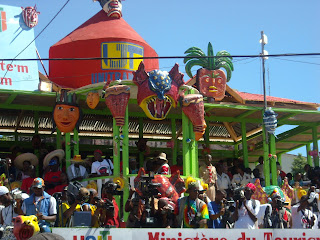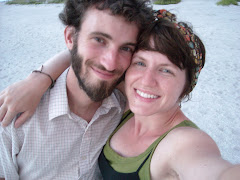Kànaval
 Nothing but the biggest celebration to hit the Catholic world each year, Kànaval is the last great splash before Lent begins. In
Nothing but the biggest celebration to hit the Catholic world each year, Kànaval is the last great splash before Lent begins. In 

 Our working hypothesis is that things creative in Haiti are usually
Our working hypothesis is that things creative in Haiti are usuallypolitical or religious. Yes, that is a MINUSTAH man getting mauled by a tiger.
The morning after we returned from Jacmel, we loaded our team into the "bus," as
11 hours after leaving Desarmes we arrived in Piedra Blanca, home base of Floresta, a reforestation program actually working on both halves of the island. They have had amazing success working with the Dominican government, which has made reforestation a national priority. (Tourism is booming, and tourists would much rather see trees than bare burnt earth and some cacti.) We toured eucalyptus and cacao forests, and also checked out Floresta’s agricultural work: oregano, cilantro, and pineapple fields.
Pineapple.
Jean, looking both studious and majestic.
Chocolate in the wild.

Our last day was spent taking in the sights of
Fritzner screaming to Frantzo, “Look! a road over our heads!” as we went under an overpass.
Nahomie whispering, Mezanmi! (“Oh my gosh!”) as the gate lifted after we dropped in our toll. (Tolls!)
Total silence as we drove past a big TV billboard; they sat enraptured.
It was a little sad for us that things that are so routine for us (and are actually nearly outmoded – who doesn’t have EZ-Pass?) were so remarkable to them. We so admire the bravery and persistence of Haitians in just living, but feel frustrated that it has to be that way – but we’ll leave the complexities of development for another post.
We decided to hop off the bus in Port, as we had decided to use the 5-day Kànaval weekend to take the bus south to Les Cayes to visit a friend. At the last minute, we were made an offer we couldn't refuse. Kurt (our new Country Representative – hooray!) and his girlfriend Hillary were headed north to the beach at Labadee and to check out Kànaval in Okap. The huge advantages for us: we wouldn’t have to sit on buses for hours, we could check out a place we’ve heard is unmissably great, and they could drop us off at our doorstep afterwards. We're in.
The town of
outside? And the fan in the corner? That's a little slice of heaven.
The next day we took the boat taxi back to Cap Haitian for Kànaval. To give you a sense of what this is like in
Returning home was bittersweet: we love to travel, but living out of a bag gets old after a week or so. Hello, garden! Hello, home cooking! We missed you.







1 comment:
I always enjoy your travel stories! and thanks for posting the pics - they're beautiful!
Post a Comment